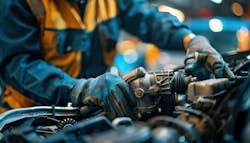Regardless of how well technicians stick to standard operating procedures and take precautions during repairs, the commercial vehicle shop is an inherently dangerous environment with a lot going on at all times.
With heavy vehicles moving in and out and lifted up and down, with plenty of slick oils and lubricants around, no bay is accident-proof. And when it comes to keeping techs protected, the most important thing management can do is ensure that their employees have the proper equipment to do the job safely.
This starts with having a good manager who recognizes the value of their technicians, and not just as skilled professionals, but as people with lives and families. When a tech is sidelined due to an injury, of course their production goes away, disrupting the smooth operation of the shop, but more importantly, that person the shop is responsible for keeping safe incurs physical pain and loss of hours, greatly impacting their life outside of work.
And again, even the most safety-conscious facilities could have an accident; it’s the response to such an incident that can spur greater success. Such was the case for LockNClimb, a manufacturer of specialized ergonomic ladders.
“Safety is what got us into the business of creating ergonomic safety ladders for mechanics,” said Banning K. Lary, communications director for the company. “We had an employee fall off a ladder and realized there had to be a better and safer way to build a ladder.”
He listed some key features of their ladders that make them especially effective at preventing falls, including extra-wide comfort treads, slip-resistant material, and 6061-grade industrial quality aluminum composition, which provides extra stability.
“We have [also] added long handrails on both sides so mechanics can easily employ the OSHA-recommended three points of contact when ascending and descending,” Lary said. “Other ladders have cages and safety chains when the platforms are above a certain height.”
Training and education are always going to be important aspects of staying safe in a shop environment as well, but quality safety equipment will make keeping your people safe and your shop operating smoothly a much less daunting task.
“Productivity is positively impacted when technicians have the right tools and equipment to perform the job safely and efficiently,” said Homer Hogg, VP of truck service operations at TravelCenters of America. “Technicians recognize when they are truly cared for, and that improves productivity and morale.”
Common injuries and solutions
While freak accidents and out-of-the-ordinary workers’ comp claims are always a possibility, there are a few injuries that occur more commonly within a CV shop environment than the rest.
Back injuries are one of the more frequent safety issues in the industry, as lifting tires and other heavy components is not unusual during CV repairs. Often thought of as the most costly workplace injury due to the long recovery time, back injuries can take weeks or even months to fully come back from.
Luckily, several back-saving products and devices are available.
Sean Price, director of sales operations for BendPak, mentioned the Mobi-EVS line of battery and powertrain lift tables, first released in 2021.
“We developed the first battery lift table to enable the ergonomic removal and installation of heavy EV batteries after watching technicians remove batteries using their own muscle or homemade tools,” Price said. “With EV batteries [often] weighing 1,000 to 4,000 lbs., trying to remove them without the proper equipment is an accident waiting to happen.”
TravelCenters’ Hogg listed a few other solutions, mentioning “tire and brake drum dollies [as a few] great tools to prevent back injuries. Dollies bear the weight of the drum or tire (two of the heaviest commonly changed parts in most shops) and use leverage to help prevent strains.”
Falls are another one of the most common injuries in the shop, according to the U.S. Bureau of Labor Statistics.
The impact that proper equipment can have on employee safety is drastic, with the same effect applying to the direct correlation between safety and shop revenue.
“In one case, a major company was spending about $5 million a year due to ladder accidents in workman’s comp claims, medical bills, and lost productivity,” Lary said. “Once they employed our ergonomic safety ladder system, along with training we provided on the proper use of our ladders, the losses in the next years were cut by about 90%.”
It’s also important for managers to continue enforcing the use of typical PPE products, as these products have been commonplace in shops for decades for good reason.
“To prevent trips and falls, go back to the basics,” Hogg emphasized. Products like safety glasses, gloves, and non-slip boots are the first line of defense against most smaller issues like cuts, slips, falls, and more.
Steps to ladder safety (OSHA)
- Read and follow all markings/labels on the ladder
- Always maintain 3-points of contact
- Do not use the top rung as a step unless it was designed for that purpose
- Use a ladder only on stable and level surfaces
- Do not place on other objects to obtain additional height
- Be sure that all locks are properly engaged
- Do not move a ladder with a person or equipment on it
About the Author

Lucas Roberto
Lucas Roberto is an Associate Editor for Fleet Maintenance magazine. He has written and produced multimedia content over the past few years and is a newcomer to the commercial vehicle industry. He holds a bachelor's in media production and a master's in communication from High Point University in North Carolina.


